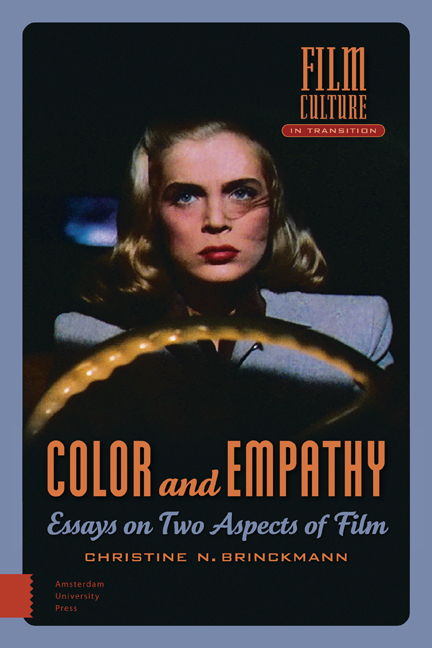Book contents
- Frontmatter
- Contents
- Preface
- Dedication
- Cinematic Color as Likeness and as Artifact: [2001]
- Chords of Color: [2006]
- The Tension of Colors in Colorized Silent Films: [2001]
- Structural Film, Structuring Color: Jenny Okun's Still Life: [1995]
- Desert Fury: A Film Noir in Color: [2012]
- The Work of the Camera: BEAU TRAVAIL: [2005]
- Empathy with the Animal: [1997]
- Motor Mimicry in Hitchcock: [1999]
- Abstraction and Empathy in the Early German Avant-garde: [1997]
- The Role of Empathy in Documentary Film: A Case Study: [2005]
- Genre Conflict in Tracey Emin’s Top Spot: [2007]
- Viewer Empathy and Mosaic Structure in Frederick Wiseman’s PRIMATE: [2009]
- CASTA DIVA: An Empathetic Reading: [2008]
- Publication Data
- Index of Films
- Index of Subjects
- Film Culture in Transition
Viewer Empathy and Mosaic Structure in Frederick Wiseman’s PRIMATE: [2009]
Published online by Cambridge University Press: 23 June 2021
- Frontmatter
- Contents
- Preface
- Dedication
- Cinematic Color as Likeness and as Artifact: [2001]
- Chords of Color: [2006]
- The Tension of Colors in Colorized Silent Films: [2001]
- Structural Film, Structuring Color: Jenny Okun's Still Life: [1995]
- Desert Fury: A Film Noir in Color: [2012]
- The Work of the Camera: BEAU TRAVAIL: [2005]
- Empathy with the Animal: [1997]
- Motor Mimicry in Hitchcock: [1999]
- Abstraction and Empathy in the Early German Avant-garde: [1997]
- The Role of Empathy in Documentary Film: A Case Study: [2005]
- Genre Conflict in Tracey Emin’s Top Spot: [2007]
- Viewer Empathy and Mosaic Structure in Frederick Wiseman’s PRIMATE: [2009]
- CASTA DIVA: An Empathetic Reading: [2008]
- Publication Data
- Index of Films
- Index of Subjects
- Film Culture in Transition
Summary
In what follows I will attempt to describe the empathetic processes that (presumably) take place in the audience while watching Frederick Wiseman’s documentary PRIMATE (US, 1973). Whereas many studies have been undertaken to analyze viewer responses to fictional films, studies on the effects of documentaries are still rare. Documentaries and fiction films have a lot in common, of course, and many findings can be transferred from one field to the other. But the genres also differ in significant ways, as most documentaries do not follow scripts, are not staged, and do not use actors. The lack of scholarly interest in the subject is thus on the one hand astonishing, since so much has yet to be discovered; on the other hand, studies in documentary response are compounded by the fact that the films vary strongly in their strategies of presentation, some resembling fictional models more than others, some more dedicated to establishing facts and causes, or to persuading the audience to take action. It is thus difficult to generalize viewer responses, let alone develop a theory that applies to the genre as such.
As a preliminary step, it is therefore useful to conduct bottom-up case studies of a whole range of documentary films. Only after a considerable number of close readings have been undertaken will response patterns emerge so that approaches can be systematized and assumptions verified. My analysis of Wiseman's PRIMATE, based on personal introspection and on findings garnered from the analysis of other works or from the field of psychology, is therefore meant to provide material for further research.
Frederick Wiseman's oeuvre differs more radically from fiction film than most documentaries. On the one hand, he follows the observational mode of Direct Cinema: Wiseman attempts to film real events as they happen, does not stage anything, does not intervene, does not use explanatory voice-overs or mood-setting music. But unlike most of his Direct Cinema colleagues – e.g. Richard Leacock, D.A. Pennebaker, and the Maysles Brothers – he does not use the observational mode to create a causal-linear chain of scenes around a central conflict; nor does he focus on individuals as protagonists or antagonists. Rather, a large group of his films (to which PRIMATE belongs) is dedicated to portraying American institutions – hospitals, schools, the military, etc.
- Type
- Chapter
- Information
- Color and EmpathyEssays on Two Aspects of Film, pp. 221 - 240Publisher: Amsterdam University PressPrint publication year: 2014



